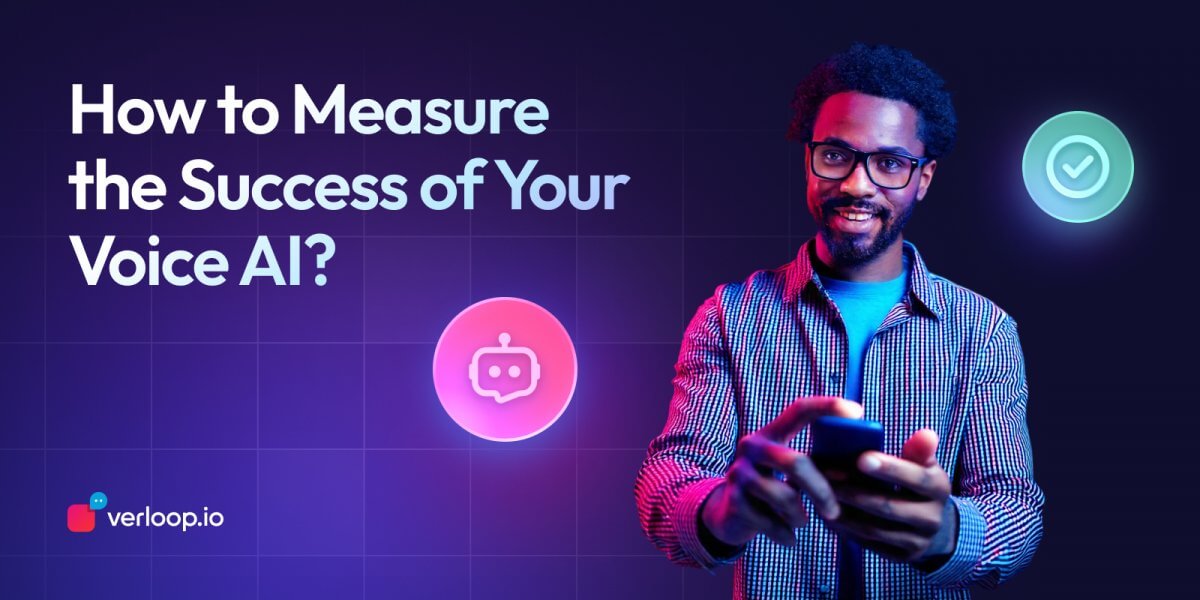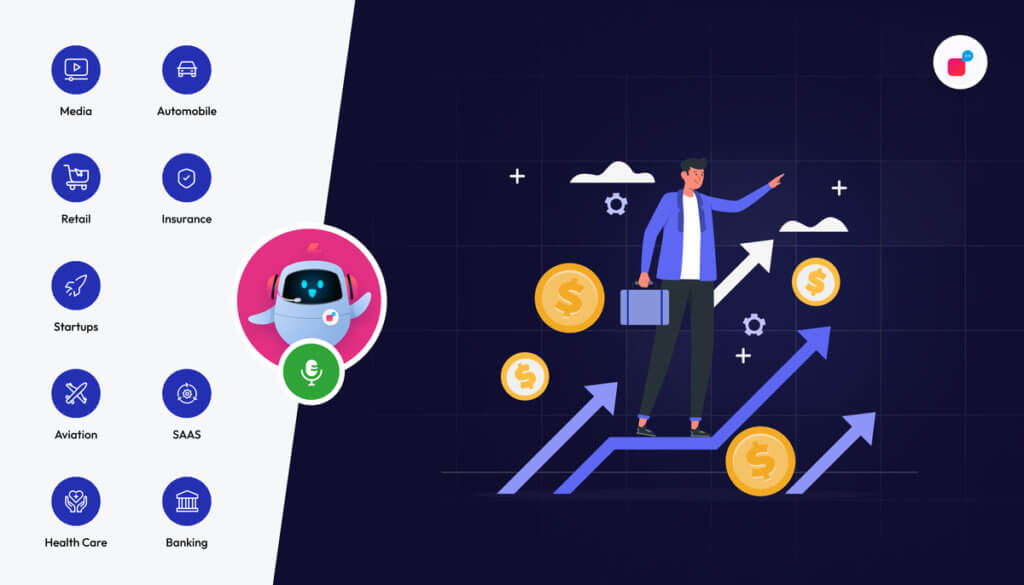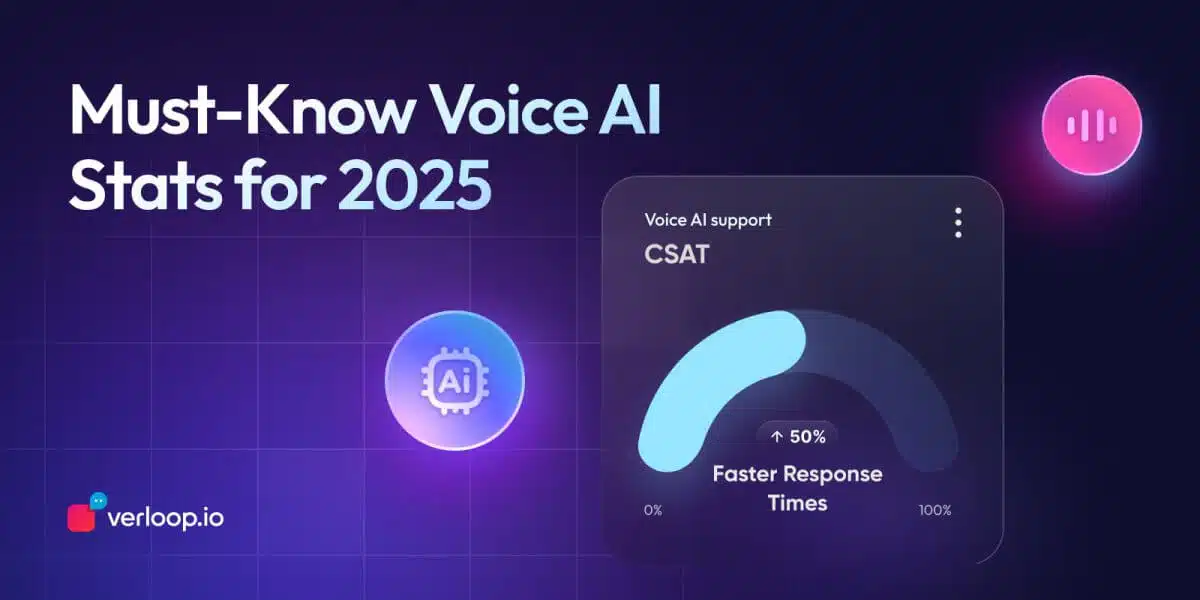
How to Measure Voice AI Performance: KPIs & Best Practices for a Voice AI Calls Platform
- February 11th, 2025 / 4 Mins read
-
Aarti Nair
As voicebots platform gain popularity, users increasingly use them for all their messaging needs. This has encouraged organisations to recognise the potential of voice AI agents for changing their processes. However, measuring the success of a voice AI system entails evaluating several key performance indicators (KPIs) to determine its ability to achieve goals and satisfy user expectations. User engagement, job completion rates, answer accuracy, and user satisfaction are all important metrics to consider when evaluating performance.
Voice AI call technology is very popular among customers, with 71% preferring it over typing. Businesses can ensure that their AI voicebot provides a flawless and satisfying user experience by regularly monitoring voice AI KPIs and modifying methods accordingly, resulting in enhanced productivity, customer happiness, and the achievement of organisational objectives.

According to Grand View Research, the global voice-based customer service market is expected to grow to $5.6 billion by 2028. This predicts rising usage and the enormous potential that voicebot calling improves customer engagement and catalysing conversions. Businesses who embrace this technology early can gain a competitive advantage and benefit on emerging market dynamics.
In this article, we will look into these queries and explain how to measure the success of voice AI. So, let us delve in and discover the mysteries of voicebot analytics!
How a Voice AI Calls Platform Transforms Customer Support
Your business is booming, but so are the customer service calls. Your support team is drowning in a sea of inquiries—order status updates, refund requests, and appointment confirmations. Customers are left hanging, waiting on hold, and some are even walking away in frustration.
Sound familiar?
With Voice AI Calls Platforms don’t just pick up the phone; they improve the entire customer service experience, saving time, slashing costs, and boosting efficiency.
1. The Answer to Scaling Without Chaos
The Problem:
Businesses, especially e-commerce and service-driven industries, face a deluge of repetitive calls. Studies show that over 60% of customer support interactions involve basic queries like order tracking, store hours, or refund policies. Traditional call centres struggle to scale cost-effectively, leading to longer wait times, high agent burnout, and frustrated customers.
The Resolution:
A Voice AI Calls Platform can handle thousands of calls simultaneously, ensuring that customers receive instant responses without queuing. For example, India’s leading online pharmacy, 1mg, leveraged voice AI to automate prescription reminders, cutting manual intervention by 50% and improving compliance rates.
2. Streamlining Customer Support
The Problem:
Customers today expect lightning-fast support. 70% of customers say speed is key to a good experience, yet human-staffed call centres can’t always keep up. When wait times stretch beyond two minutes, nearly 60% of callers abandon the call—often turning to competitors.
The Resolution:
Voice bots can handle FAQs like “Where’s my order?”, “What’s your refund policy?”, or “Can I reschedule my appointment?” without human intervention. A UAE-based fashion retailer saw a 40% drop in support costs after implementing a voice AI solution for post-purchase inquiries, leading to a 30% increase in customer satisfaction scores.
3. Enhancing Lead Qualification
The Problem:
Not every inbound call is worth a sales rep’s time. Many calls are low-intent inquiries, while high-intent customers—those ready to buy—get stuck in long queues or dropped calls. This results in missed revenue opportunities and inefficient use of sales resources.
The Resolution:
AI-powered voice assistants pre-qualify leads by asking key questions before passing them to a human agent. For example, a Middle Eastern fintech firm automated its loan application calls, using voice AI to gather income details, eligibility criteria, and intent level. This streamlined process cut lead processing time by 60% and improved conversion rates by 35%.
Voice AI isn’t just about answering calls—it’s about transforming business operations. Whether it’s managing high call volumes, improving support efficiency, or ensuring sales teams focus on the right leads, these AI-driven assistants help businesses scale without breaking the bank or burning out employees.
With brands across India, the UAE, and beyond seeing tangible benefits—lower costs, higher efficiency, and happier customers—the question isn’t if businesses should adopt voice AI, but how soon.
3 Important Stats for Measuring Your AI Voicebot’s Performance
Now, let’s look at the stats that matter. Because what’s the purpose of having a saviour if you don’t know how to evaluate voicebot performance? Here are the crucial statistics to look out for:
1. Customer Satisfaction
This customer satisfaction metric assesses users’ satisfaction with their interactions with the voicebot. It can be evaluated using surveys, feedback, or sentiment analysis.
But how do you assess CSAT? Simple. Ask your customers. Collect their input, analyse it, and voila, you have your CSAT score. A high score indicates that your AI voicebot is a hit. Want to go even higher? Optimise, improve and personalise.
2. Completion Rate
This metric measures the percentage of engagements the voicebot completes successfully without human involvement. It reflects the bot’s capacity to manage consumer requests efficiently.
Calculating is simple. Set benchmarks, see how your bot compares, and improve its abilities. Verloop.io, with its intent recognition abilities, guarantees a high success rate. Customers get what they need quickly.
3. Return on Investment
This compares the financial gains from adapting the AI voicebot to the costs paid. It considers lower customer service costs, higher revenue, and better operational efficiency.
Calculate it using the formula:
(Net Profit – Investment Cost) / Investment Cost x 100
Strategies for maximising ROI – Smart deployment and ongoing tweaking of your AI voicebot to ensure top performance.
10 KPIs to Measure Voice AI Calls Performance & Optimise Your Voice Assistant Call Software
Now, let’s look further into the KPIs that truly evaluate the voice AI’s success. Here are ten measures to watch out for:
Technical Metrics
1. Net Promoter Score (NPS)
The Net Promoter Score (NPS) is a significant metric for evaluating customer satisfaction and loyalty. It depends on a single question: “How likely are you to recommend our product/service to a friend or colleague?”. Respondents are usually rated on a scale from 0 to 10. Promoters respond with 9 or 10, whereas detractors react with 0-6. NPS is calculated by subtracting the critics’ and promoters’ percentages.
2. First Call Resolution Rate
The First Call Resolution Rate is an essential customer service metric that assesses support teams’ efficiency and effectiveness. It calculates the percentage of client inquiries or concerns resolved during the first customer service interaction. A high first-call resolution rate indicates that customer expectations are swiftly met, eliminating the need for follow-up calls or escalations. This not only boosts customer satisfaction but also reduces operating costs and improves overall service quality.
3. Call Handling Time
Call handling time is the average time it takes for customer care representatives to complete a call from beginning to end, including talk time and post-call actions. It is an essential metric for assessing the performance of a call centre or customer support team. Monitoring call handling time enables businesses to identify areas for improvement, optimise systems, and promptly respond to client issues. Reduced call processing time frequently correlates with increased customer satisfaction and operational efficiency.
4. First Response Rate
The First Response Rate is an important metric that measures how well customer care professionals respond to initial consumer questions. It refers to the percentage of client messages or questions that receive a first response within a predetermined time frame, usually measured in minutes or hours. A high First Response Rate displays proactive and prompt customer service, essential for maintaining customer satisfaction and trust. Monitoring this statistic enables companies to prioritise and optimise response times, improving customer experience.
5. Average Handling Time
Average Handling Time (AHT) is a crucial metric in customer service that reflects how long it takes to handle a client interaction, such as a phone call, email, chat, or query. It comprises time spent addressing the customer’s queries, resolving their issue, and carrying out any necessary follow-up tasks. Monitoring AHT allows businesses to improve operations, distribute resources more efficiently, and give timely assistance, resulting in higher customer satisfaction and operational effectiveness.
6. Number of Calls Handled
The number of calls handled is an essential indicator for determining the productivity and burden of customer support staff, especially in online and voice-based customer care environments. It reflects the number of calls voicebots handle during a specific period. Monitoring this metric enables organisations to assess agent productivity, efficiently allocate resources, and discover changes in consumer communication preferences. A higher number of calls handled could suggest more demand or efficiency in responding to consumer inquiries.
7. Bot Deflection Rate
Bot deflection rate is an essential indicator for measuring how effectively voicebots handle customer queries without human intervention. It represents the percentage of queries successfully answered by the voicebot, reducing the pressure on human agents. Monitoring this allows organisations to evaluate the success of their voicebot systems and optimise them for improved customer service efficiency. A higher bot deflection rate suggests successful automation and a better customer experience via faster responses.
Business Related Metrics
8. User Retention Rate
The user retention rate is a crucial business indicator that calculates the percentage of customers who continue using a product or service after a specific period. It assesses customer satisfaction, loyalty, and a company’s overall health. Organisations that track user retention rates can identify trends, evaluate the efficiency of their products or services, and develop client retention strategies. A high retention rate indicates a solid client base, contributing to long-term business success and profitability.
9. Scalability
Scalability refers to a system’s ability to handle an increasing workload or demand while preserving performance and dependability. It is a crucial issue for businesses as they grow and encounter more customers, transactions, or data. It assesses the bot’s capacity to cope with increased usage and workload as demand develops. A scalable voicebot can handle more users and interactions without sacrificing performance or user experience. This ensures that the bot can efficiently support corporate growth while adapting to changing needs and market circumstances, resulting in long-term success and meeting business objectives.
10. Latency
Latency is a crucial business metric. It quantifies the time between the user’s question and the voiecbot’s response, influencing user experience and satisfaction. High latency might cause frustration and dissuade people from interacting with the voicebot. Businesses provide a smoother contact process by reducing latency, encouraging better user experiences, and ultimately driving higher engagement and retention rates, which are critical for the voicebot’s success.
Voice AI Performance: Measure the Road to Success
A well-developed AI voicebot can significantly impact a company’s success in customer support automation in various ways. It improves efficiency by processing basic inquiries, allowing human agents to focus on more complex issues, resulting in faster response times and more customer satisfaction.
Second, it provides 24/7 support, allowing businesses to assist clients in several time zones and improve accessibility. AI voicebots can also provide personalised interactions by analysing consumer data and preferences, resulting in more specialised solutions and better customer experiences. Furthermore, they help to save costs by automating repetitive operations and removing the need for additional support staff. A powerful AI voice bot can improve customer service, increase consumer engagement, and ultimately raise corporate performance.
Integrating voice AI data solutions can elevate customer support automation to the next level. Verloop.io provides advanced AI-powered voicebots that are customisable, scalable, and able to handle complicated interactions. Verloop.io’s Voice AI solutions, which include natural language processing, LLM and sentiment analysis, may give customers a smooth and personalised experience, resulting in increased satisfaction and retention. To observe Verloop.io’s Voice AI solutions, visit our demo page today.








